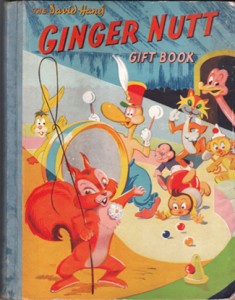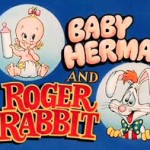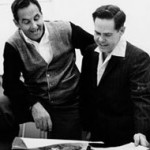David Hand in Denmark. From an old Toronto Canada Animation Society newsletter was a fascinating article by animator Kaj Pindal on legendary Disney animator and director David Hand. Here is an excerpt:

“In 1944, J. Arthur Rank sent for Hand to come to England to build up an animation industry along the lines of the Disney Studio. They set up shop in an old country house in the village of Cookham in Berkshire under the name G.B. Animation. Hand had a big office and a large salary while two hundred young English artists worked in quanset huts.
“In 1949, I worked for Borge Ring. We had an animation commune in a large house north of Copenhagen. We were four animators who lived and worked there: Borge Ring, Kjeld Simonsen, Frank Jenson and myself. Borge found out about Hand’s studo in England and went there to show our work and ask questions. Hand liked what he saw and he wanted us all to come to Cookham, but the English union wouldn’t allow it.

“Then early in 1950, we learned that Arthur Rank for some reason did not renew his contract with Hand. We were shocked but Borge immediately invited Hand to come to Denmark. We could not offer him money, but we arranged an apartment in our house where he and his wife Mandy stayed. During the following months, Hand conducted classes in animation. We learned storyboarding, timing, staging and to shoot Leica reels and line tests and to analyze, analyze, analyze. He stressed exaggeration – to dare to go to extemes and beyond.
“He would have liked to stay and we would have liked to keep him but we had no money at all. Hand wanted to produce Robin Hood as an animated feature. Nordisk film (Great Northern Film Company) was interested and there were serious negotiations. But it fell through on Hand’s salary demands, which were quite outrageous by Danish 1950 standards. Eventually Hand and his wife left and we never saw him again.
“For me, however, he remains the giant American who stepped down from his cloud to our little post-war Danish world and gave away the secrets of the biggest magic of all: animation.”
Never Watch. Don Bluth told reporter Lynn Minton in 1986 that “seven year old Phillip Glasser who plays Fievel’s voice (in An American Tail 1986) never knew he was playing a mouse, and he got just the right emotions – happy, sad, longing – into his performance. Then one day we showed him the rushes, with his voice coming from the little mouse. After that, he started talking like a mouse, and we never showed him the rushes again.”
What Did He Say? The weird “alien talk” heard in Ub Iwerks Willie Whopper cartoon Stratos-Fear (1933) is actually someone singing the song “Yankee Doodle” played backwards.
Clutch Cargo Homage. When animator Dan Haskett was attending the School of Visual Arts in New York, he worked on a film called Clutch Fargo using “SuperAniMouthTion”. The students held still photos up to the camera and stuck their own mouths through holes cut in the faces. A run cycle consisted of two photos of a character, repeated endlessly.
 Roger Rabbit Sequel. The New York Times June 29, 1988 reported that Disney chairman Michael Eisner had told columnist Marilyn Beck that he had set the summer of 1991 as the target date for the sequel to Who Framed Roger Rabbit (1988). “We have to start work in six weeks or so,” stated Eisner. “Remember, we invested over three years in Roger Rabbit. In the next one, he becomes a daddy.” However, when this was reported to Jeffrey Katzenberg, he replied, “There are no immediate plans for a sequel. I only hope that we’re so lucky that Mr. Zemeckis and Mr. Spielberg will make us a sequel.”
Roger Rabbit Sequel. The New York Times June 29, 1988 reported that Disney chairman Michael Eisner had told columnist Marilyn Beck that he had set the summer of 1991 as the target date for the sequel to Who Framed Roger Rabbit (1988). “We have to start work in six weeks or so,” stated Eisner. “Remember, we invested over three years in Roger Rabbit. In the next one, he becomes a daddy.” However, when this was reported to Jeffrey Katzenberg, he replied, “There are no immediate plans for a sequel. I only hope that we’re so lucky that Mr. Zemeckis and Mr. Spielberg will make us a sequel.”
 Zemeckis on Jessica Rabbit. From Variety, June 20, 1988: Actress Kathleen Turner who requested anonymity and refused screen credit as the voice of Jessica Rabbit in Who Framed Roger Rabbit (1988) did show up at the Radio City Music Hall premiere. Also there was director Robert Zemeckis who had directed Turner in Romancing the Stone (1984). When talking about the character of Jessica, Zemeckis said, “I could never get Kathleen’s voice out of my head. She just had to do it. And, fortunately, she immediately said ‘yes’. The real life model is Betsy Brantley who is very beautiful but sensuous in a girl-next-door way. Jessica is a testament to what can be done with man’s imagination – and a pencil.”
Zemeckis on Jessica Rabbit. From Variety, June 20, 1988: Actress Kathleen Turner who requested anonymity and refused screen credit as the voice of Jessica Rabbit in Who Framed Roger Rabbit (1988) did show up at the Radio City Music Hall premiere. Also there was director Robert Zemeckis who had directed Turner in Romancing the Stone (1984). When talking about the character of Jessica, Zemeckis said, “I could never get Kathleen’s voice out of my head. She just had to do it. And, fortunately, she immediately said ‘yes’. The real life model is Betsy Brantley who is very beautiful but sensuous in a girl-next-door way. Jessica is a testament to what can be done with man’s imagination – and a pencil.”
Daws Butler. In the Los Angeles Times May 20, 1988, animation producer Joe Barbera recalled the first time he met voice artist Daws Butler. “Here comes Daws, this little man, and he’s so filled with enthusiasm,” stated Barbera. “He helped find the voices for our two original characters, Ruff and Reddy, and then when I told him we were going to do a laid back dog and needed a Southern accent, he gave us versions of dialects for each of the Southern states.
“He was so knowledgeable in the way that he spoke them – one for nearly each state – it helped shape what became Huckleberry Hound. What always amazed me was that his own speaking voice was not inspiring at all…kind of non-descriptive. But then he’d do all those wonderful dialects and just fire us all up.”
 Lloyd Vaughan. Lloyd Vaughan had a fifty-one year career in animation mostly at Warner Brothers when he died in 1988. Vaughan lost the sight in his right eye before he started his cartooning career. “He didn’t have any real experience, but he had a dream. He wanted to work for Disney,” said his wife. “So, he had a friend who was a publicity agent for Marion Davies, Frank Heacock, arrange to get him an interview at Disney’s studio. He had no portfolio, so he showed them some drawings he had done and they told him they didn’t quite come up to their standards and also that he was too old to start. He was 26.” The year was 1935 and Vaughan just walked over the Leon Schlesinger studio who hired him for six dollars a week. He was so good that the next month he got twelve dollars a week. For awhile, he served as editor for The Animator, the newsletter of the Screen Cartoonists Guild.
Lloyd Vaughan. Lloyd Vaughan had a fifty-one year career in animation mostly at Warner Brothers when he died in 1988. Vaughan lost the sight in his right eye before he started his cartooning career. “He didn’t have any real experience, but he had a dream. He wanted to work for Disney,” said his wife. “So, he had a friend who was a publicity agent for Marion Davies, Frank Heacock, arrange to get him an interview at Disney’s studio. He had no portfolio, so he showed them some drawings he had done and they told him they didn’t quite come up to their standards and also that he was too old to start. He was 26.” The year was 1935 and Vaughan just walked over the Leon Schlesinger studio who hired him for six dollars a week. He was so good that the next month he got twelve dollars a week. For awhile, he served as editor for The Animator, the newsletter of the Screen Cartoonists Guild.



 Jim Korkis is an internationally respected animation historian who in recent years has devoted his attention to the many worlds of Disney. He was a columnist for a variety of animation magazines. With his former writing partner, John Cawley, he authored several animation related books including The Encyclopedia of Cartoon Superstars, How to Create Animation, Cartoon Confidential and Get Animated’s Animation Art Buyer’s Guide. He taught animation classes at the Disney Institute in Florida as well as instructing classes on acting and animation history for Disney Feature Animation: Florida.
Jim Korkis is an internationally respected animation historian who in recent years has devoted his attention to the many worlds of Disney. He was a columnist for a variety of animation magazines. With his former writing partner, John Cawley, he authored several animation related books including The Encyclopedia of Cartoon Superstars, How to Create Animation, Cartoon Confidential and Get Animated’s Animation Art Buyer’s Guide. He taught animation classes at the Disney Institute in Florida as well as instructing classes on acting and animation history for Disney Feature Animation: Florida.




















































I got another animation anecdote to share. According to Colin White’s biography of Edmund Dulac,
the famed illustrator created titles for Lotte Reiniger’s silhouette film, The Adventures of Prince Achmed (1926).
According what I heard about the Roger Rabbit sequel that it might be planning to be released next year.
But they’re not sure of the plot if it’s going to be during WWII with Roger fight the Nazi Sympathizers and Fifth Columnist in Toon Town or how Roger became a Toon star .
And if they do have a sequel I wonder which Toon stars of that era will be part of the movie?
The Roger Rabbit sequel was shelved a few years back. Reason given was that it would have cost too much to make. There’s also the question of how big an audience there’d be for a sequel to a movie that’s nearly thirty years old. The script for the sequel that was finally agreed upon was about Roger breaking into show business. Spielberg killed the toons vs. nazis story, his post-SCHINDLER’S LIST feelings being that nazis were no longer appropriate comic villains
The original movie came out when there were plenty of adults who were raised on old theatrical toons on TV, and there were still a lot of kids who got old Warner toons on local stations. WFRR depended on audiences not only recognizing the characters but knowing all the cliches. That may be a bigger factor than the age of WFRR itself.
There’s more backward talking in “Stratos Fear”. Besides the alien scientist chuckling and singing “Yankee Doodle”, he grills Willie – his words in reverse are “one two three four five six seven” in rapid fire. And the alien astronomer calls out what sounds like a bunch of fragments when you reverse them – something like “I’ve done something here – see, the traffic here – I’m gonna pick New York, did you? Hey!”
I remember visiting Mark Kausler at Disney when I worked for the Festival of Animation, and he showed us a whole storyboard for a Roger Rabbit short which got scrapped. I think at the same time, others in the warehouse were working on an early version of Fantasia II, which also got scrapped. Saw lots of work for things that never happened!